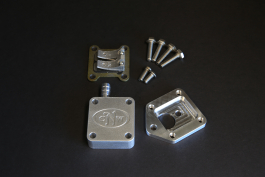To Elaborate , the oil in the tank goes past the oil pump gearwheels , back into the engine , under gravity . if its not all 1000 % .
Its pretty normal , to have a little grey smoke , a puff & a minute or two to clear . Stops the mufflers rotting .
Its Normal to face the pump body & endplate on glass with grinding paste to around a thou. end float . No More .
But in say 10.000 miles , it mightve got out past the thou. So that Oil under gravity quitely seeps past . Overnight .
Thrown on the bore walls by the flywheel , it lubes the bores rings & pistons salubriously at start up .
Like oil leaks keeping the salt off and stopping it rusting , The Neigbours might be worried . Let them .
Only if it fouled plugs , would you have to pull your finger out , pull the timing cover , and service the pump .
OIL: CHANGE . cunning swine have a accessable - remooveable - oil return line . Tank End .
DrainTank . Inspect with flashlight . A lint free rag on a stick , to degook gunge in the bottom . If Prescent .
Said cunning sods ALSO have a strong magnetr on the Oil Tank ( and engine ? ? ) DRAIN PLUG .
To collect magnetic particals .
Like Old ' element ' oil filters in detachable permanent canisters , rather than current disposeable ones .
The R A F mechaics Checked the Filters for ' forign matter ( and bits of engine ) before setting the aces
loose on the Hun .
So thats THAT .
With the tank & cap cleaned and replenished AFTER youve replaced the drian plug , Fire it up with the return line
into a milk jug or suchlike , After a minute or less , there should be only virgin oil emergeing . Shut Down . Refit Oil Return to Tank,
and youve 100% New Oil . Uncontaminated by reminants of previous lot .
This is why CAR you whip the filtrer off HOT to drain the oilways . They can contain a good amount . And drain sump immeditely after .
A 1/2 hour lets it all drain down , from upp top & the insides . Before filling filter refitting and replenishing sump. Plug Insalled
so 2 gallons oof 6 / 110 oil dont end up at the back wall off the garage at floor level . We Double Check THE PLUG . Nip , then Firm .
Overtigtening and the tank / sump threads suffer . As you will later then . CLEAN the threads , plug , washer off . And Washer .
Have A PLACE to PUT THEM untill required . So as not to play ' Hunt the Sump / Tank drain plug '' . Then CHECK LEVEL
take it round the block , And Check Level Again after returning . THEN you can figure consumption / Milage .
Jags were 1000 miles per pint , or so . And had FELT engine oil filters . That needed WASHING at serviceing . Or clogged and
indicated low oil pressure . Where it wernt if cleaned . The NORTON is just a GAUZE SCREEN to collect rocks and small children who fall in .
Therefore were a bit fussy regarding grit and dirt road dust about the cap & fittings . A bit of oil film collects it , but it hoses off leaving the machineary preserved . KERO in the Steam Cleaner keeps it rust free . Hot Water Only . Watch It . The Olde Oxide will get going in moments .
A V slight damp patch at the head gaskets notta worry . bubbling when running would be .
Heating copper gasket red hot and dropping into water ,softens / anneals it . They REUSED them too . Unless damadsged .
Of course copper graphite paste , KoperKoat , was used in Nitro Burning Triumphs to keep the combustion internal , on the Salt.
Wash , clean , reaneal , and reuse Copper Gasket . Often even works on fancy laminated modern gaskets . As they Dont Stick and tear , removing them .
Coppr Coat is Pressure Sealing Anti Sieze Compound . A BSAestte used Steam Pipe bituminised pressure sealing gasket paper to make all but head gasket , the only mark on the dust coated bike after a back road cruise was a petrol drip from having used the tickler on the Concentrics . The left one , on the side stand . And THATS ANOTHER THING .
Get Used to Balancing it Whist Leaping skyward , kick start ENGAGED beforehand after having pushed thru to Near T D C
From Cold , Free Clutch , prime carbs , push through four compressions to prime . THEN ' Contact - Switches ON ' and it'll one kick light up .
Quite halarios hearing hilarity at the pushing it through " Arrghhj It wont start . twitter giggle " deafed at the first compression with intent .
So waner round it to see the wings arnt falling off , or the preopellor . Gun Switches ' safe ' . Before ' all clear ' ' Chocks Away ' .
At which stage your full attention is available FORWARD for obsticlal obstructions and intruders ! . Like the Flying Scotsman .
Brakes Checked . Throttle ' on ' . Feet Aboard Imediately . Swiftly and with style . ! Instruction for the operatrion of correctly :
xiv, 178 pages : 21 cm
archive.org
Take No prisoners .

coloradonortonworks.net



